What do we mean by electrical connectors?
The term electrical connectors can refer to any number of pieces of equipment that are used to connect one wire or cable to another, or to terminate a wire or cable. Another way to think about it is that electrical connectors are simply used to connect electrical parts together. The reason that there are so many different electrical connector types is that different applications require different solutions. This article is aimed at identifying the most common types of electrical connectors you’ll use, where to use them, and how to use them. The first thing to do is look at the different electrical connector types.
"The reason that there are so many different electrical connector types is that different applications require different solutions."
Electrical connector types

The most common type of electrical connectors are crimp connectors. Crimp connectors are any type of electrical connector that requires a crimp to be properly installed. A crimp is where a metal terminal is bent around a stripped wire. Think of it like this, a wire connector has a hollow barrel that a stripped wire is inserted into. That hollow barrel is then crushed, or crimped, to compress and form around the wire creating a semi-permanent bond. So many of the types of electrical connectors we use on a daily basis are considered crimp connectors.
The other common type of connector is simply referred to as electrical connectors. These are basically anything that is not a crimp connector (although technically crimp connectors are electrical connectors). That means they require a different method for installation. It could be soldering, compression seals, or any other form of connection that does not require a crimp.
Now that we have covered the basic explanation of electrical connectors, you should understand why crimp connectors are considered separately. Let us take a look at the various types of crimp connectors you are likely to run into.
Types of crimp connectors
Crimp connectors come in a vast array of styles and types. This is due to the fact that different applications have different criteria and as such, need different solutions. A fork terminal cannot perform the same function as a butt splice and vice versa. This is why is it imperative to know in which applications each connector excels and, better yet, how and where to use them.
Click on any of the terminal names below to be taken to that connectors section.
Or Jump directly to the installation video section.
Rings
![]()
Ring terminals are one of the most common types of electrical wire connectors you’re likely to run into. They offer a solid connection with zero chance of disconnection at the stud. One reason they are such a common connector is the fact that they are extremely easily to install and maintain. One advantage of ring terminals is that they can be easily disconnected when needed. These types of crimp connectors are ideal for busbars, terminal blocks, and feed-through-connectors. Basically anywhere you need to create a semi-permanent electrical connection.

- Main functions: Connecting to busbars, terminal blocks, and feed-through-connectors
- Safe for Marine Usage: Yes (Important Note: epoxy lined heat shrink offers the highest protection)
- Proper Tools:
VTTR50 (heat shrink, nylon, vinyl)
VTR-490 (heat shrink, nylon, vinyl, bare) - How to Install: See video section below
Forks
Fork terminals are crimp connectors that are designed to be quickly and easily disconnected from a stud. Unlike ring terminals, with fork terminals you do not need to remove the nut and other electrical connectors. Since one side of the fork is open, loosening the nut is enough to quickly release the fork terminal. There are two main types of fork terminals, locking forks which hug the body of the stud, and flanged forks which hook the underside of the nut. Both are solid choices for quality connections and really boil down to preference.
![]()
- Main functions: Connecting to busbars, power posts, and fuse blocks
- Safe for Marine Usage: Yes (Epoxy lined heat shrink = highest protection)
- Proper Tools:
VTTR50 (heat shrink, nylon, vinyl)
VTR-490 (heat shrink, nylon, vinyl, bare) - How to Install: See video section below
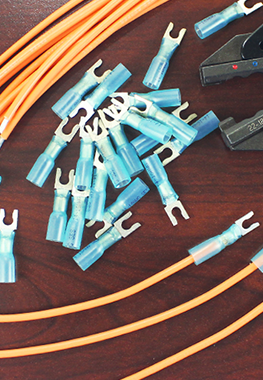
PRO TIP: Using Epoxy-Lined Heat Shrink will give your electrical connections the highest protection against environmental hazards possible.
Lugs
![]()
Lugs are quite different from ring terminals. They are generally larger, and as such, meant more for cable than wire. They have a larger diameter body and are usually closed off at one end for high-level protection. Since these types of crimp connectors are built to be more durable, lugs can handle more weight, more current, and heavier exposure to elemental conditions. Oftentimes, these types of crimp connectors are used in connecting the battery to other batteries or pieces of equipment.
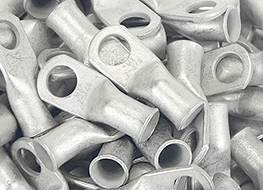
- Main functions: Connecting equipment to a battery, connecting multiple batteries together
- Safe for Marine Usage: Yes, tin-plating makes them resistant to corrosion and long-term exposure
- Proper Tools:
VT0280 (easily crimps 6AWG to 4/0AWG) - How to Install: See video section below
Splices
Butt splices are a bit different than the terminals we’ve looked at so far. The previous terminals connect wires or cables to equipment whereas splices are used to connect wires and cables to other wires and cables. These electrical connector types are known for their highly durable use in harsh conditions. Rather than run a whole new wire, splices give you the ability to connect an additional wire to an electrical system. Although there are a wide range of splices available, the two most common electrical connector types are what are considered traditional splices as well as step-down splices.
![]()
- Main functions: Connecting two or more wires together, replacing damaged wire sections
- Safe for Marine Usage: Yes (Epoxy lined heat shrink = highest protection)
- Proper Tools:
VTTR50 (heat shrink, nylon, vinyl) - How to Install: See video section below

Disconnects
![]()
Not all applications call for permanent electrical connections. This is where disconnects are meant to excel. These types of crimp connectors are built for field serviceability, built specifically to be connected, disconnected, and connected again. This makes them ideal for applications where maintenance and repair are considerations. To make them even better, they can be installed permanently if desired. Disconnect terminals come in a wide range of styles in order to meet different demands.
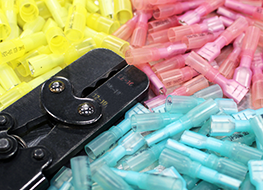
- Main functions: Creating electrical connections that can be separated
- Safe for Marine Usage: Yes (Important Note: epoxy lined heat shrink offers the highest protection)
- Proper Tools:
VTTR50 (heat shrink, nylon, vinyl)
VTR-490 (heat shrink, nylon, vinyl, bare) - How to Install: See video section below
PRO TIP: Disconnects are perfect electrical connectors for field service and can handle tough industrial conditions.
Bullets
Bullet crimp connectors are quite similar to disconnects; in fact they are a sub-category of them. The difference is whereas other disconnects rely on a tongue and tab system, bullet use an entirely different connection method. These types of crimp connectors are built for long-term usage. The male has a knob end, and the female has a barrel end. This allows for easy access to the electrical connection. They simply snap together and, with a little effort, pull apart.
![]()
- Main functions: Connecting two wires together or replacing damaged wire sections
- Safe for Marine Usage: Yes (Epoxy lined heat shrink = highest protection)
- Proper Tools:
VTTR50 (heat shrink, nylon, vinyl) - How to Install: See video section below
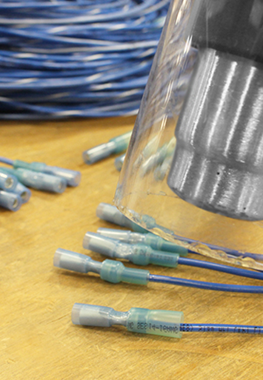
Wire Ferrules
![]()
Wire ferrules are primarily used to create a solid wire out of stranded wire. Basically, the wire ferrule is a sleeve that fits over a stranded wire. Once crimped, the barrel of the ferrule is like a solid wire. This makes them ideal for use on European terminal blocks and other locations where a screw is used to clamp down on a wire. These crimp connectors are perfect for harsh environmental conditions. Without a wire ferrule, the screw would cause a stranded wire to fray and lose contact. That, in turn, would cause a loss in conductivity.

- Main functions: Turning stranded wire into solid
- Safe for Marine Usage: Yes
- Proper Tools:
VT-PZUS (26-10 AWG)
VT-PZU16 (7-6 AWG)
VT-PZU35 (4-2 AWG) - How to Install: See video section below
Wire Joints
The term wire joints refer to the types of electrical connectors that join two or more wires together. At first glance, these crimp connectors may seem like butt splices. The difference is that splice have two ends and are designed to fit in-line with a running wire or cable. Wire joints on the other hand have only one end which allows them to perform more tasks. On top of being electrical wire connectors, they can be used to cap off a wire or create a wire dead-end.
![]()
- Main functions: Connecting wires together or creating dead-ends
- Safe for Marine Usage: Yes
- Proper Tools:
VTTR50 (22-10 AWG) - How to Install: Video Coming Soon
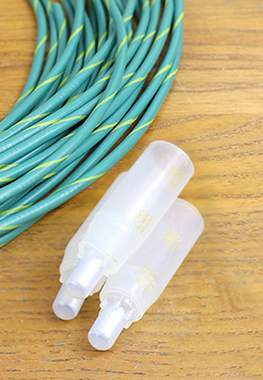
Piggyback Connectors
![]()
Piggyback electrical wire connectors are used when multiple connections are required. More specifically, they are used when a limited number of male tabs are available to connect to. Piggybacks electrical wire connectors allow another tab type connector to snap into its back. Simply put, they let you connect to a female connector while accepting a separate male connector. They are built to be easy to use and durable in the harshest marine conditions out there.

- Main functions: Connecting to an electrical system while creating an open spot to accept another connector
- Safe for Marine Usage: Yes
- Proper Tools:
VTTR50 (heat shrink, nylon, vinyl) - How to Install: See video section below
Battery Posts
Battery posts connect a load to a battery. They can be used with single cell or multiple cell batteries. Being made from 131 contact copper, they are highly conductive and resistant to corrosion. The copper used is 95% pure leading to high conductivity. All our lugs are electro-plated with tin making them ideal for the toughest marine conditions. These types of crimp connectors are built to handle the harshest conditions out there.
![]()
- Main functions: Connecting a battery cable to a battery
- Safe for Marine Usage: Yes
- Proper Tools:
VT0280 (6-4/0 AWG) - How to Install: Video Coming Soon

Installation Videos:
Below you will find multiple videos showing you the proper way to install various types of crimp connectors. Each of the types of crimp connectors we offer will have a video here making installation that much easier.
Ring Terminal
Installation
Shareable Link: https://www.youtube.com/watch?v=bODeHs6InPw
Properly Using Fork Terminals
Shareable Link: https://www.youtube.com/watch?v=OV3ma8eT5hw
Properly Installing Closed End Lugs
Shareable Link: https://www.youtube.com/watch?v=wHfXTu3XyPw
How to Use Heat Shrink Butt Splices
Shareable Link: https://www.youtube.com/watch
?v=aij2ve4iq-A
Properly Installing Disconnect Terminals Shareable Link: https://www.youtube.com/watch?v=kwp-7hkrxx4
Properly Installing Bullet Terminals
Shareable Link: https://www.youtube.com/watch?v=U5jdhjZLzpY
Properly Installing Wire Ferrules
Shareable Link: https://www.youtube.com/watch?v=--pkrJmqA3o
Properly Installing Piggyback Terminals
Shareable Link: https://www.youtube.com/watch?v=c6AmClpxeKg

